What Managers Really Think About Social Business
We asked thousands of managers to tell us how their companies are using social media tools — and how important those tools are becoming to their organizations. Here’s what they told us.
Topics
Social Business

Companies such as McDonald’s, IBM and SAP are at the cutting edge of social business practice. Hasso Plattner, SAP cofounder and chairman of the board, seeks feedback from SAP mentors, who are nominated by SAP’s online community.
Image courtesy of McDonald’s.
These days, the enterprise resource planning software company SAP has an online community with more than 2 million members, including customers, partners and others. The SAP community network is a source of trustworthy information about SAP products from (and for) the people who use them.
SAP uses this network in several interesting ways. Each year since 2007, the SAP online community has nominated roughly 100 members to be SAP mentors — influencers recognized for their subject matter expertise and their willingness to mentor other community members.1 SAP mentors are expected to mentor SAP itself. They have extra access to product managers and can influence product development. As Mark Yolton, senior vice president of SAP communities and social media, explains, these mentors also give feedback to SAP’s executive team:
Hasso Plattner, our cofounder and chairman of the board, invites mentors to brainstorm with him. No PowerPoint, no set agenda. He just gets a bunch of mentors in the room, usually at one of our big events. They give him honest feedback from the field about what’s really going on with our customers and our partners and our employees as well. Our co-CEOs and a board member, who is responsible for innovation at SAP, also meet with the mentors to hear their feedback. Mentors are people in our community who are very engaged with SAP partners and customers. They have a great deal of influence on outside perceptions of SAP, on influencing our own product direction and on our strategy.
SAP’s evolving use of its online community for increasingly strategic purposes highlights several important questions. Given that technology-based social networking has been transforming social norms on a global scale for the past decade, will social networking and social software have a similarly transformative effect on business? Are they already doing so? What kinds of enterprises are benefiting the most? And how are they benefiting?
The Leading Question
How are companies approaching social business?
Findings
- The importance of social business to organizations is expected to grow over the next few years.
- Media and technology industries are early adopters.
- Respondents indicated that the top two business challenges that could be addressed by social software were managing customer relationships and innovating for competitive differentiation.
To answer these questions, MIT Sloan Management Review and Deloitte2 conducted a survey of managers from companies in 115 countries and 24 industries. (See “About the Research.”) We had 3,478 respondents to our questionnaire. They represented a wide range of management roles (from coordinators to board directors), functional areas and business sizes. In our survey, we asked managers about social business, which we defined as business activities that use social media, social software and social networks. (See “Social Business Defined.”) We supplemented the analysis of our survey results with interviews with thought leaders and business executives, including conversations with senior managers from companies at the cutting edge of social business practice, such as McDonald’s, IBM, salesforce.com, SAP and Yammer.
Almost all of the business leaders we interviewed describe their social business efforts in terms of “infancy” or “just beginning,” or “early days.” Those with sophisticated social networks, including IBM and SAP, stressed that these have taken years to develop. Mark Yolton told us that SAP has taken nearly a decade to refine its developer network, and they are still improving upon it. IBM has been developing its enterprisewide social network for at least 15 years.
The importance of social business to organizations is expected to grow over the next few years. While just 18% of all survey respondents believe social software is important to their organization today, 63% say it will be important in three years. (See “Social Software Will Grow in Importance.”) Charlene Li, author of the book Open Leadership and founder of the research-based advisory firm Altimeter Group, described to us the growing importance of social business:
Over the past few years there’s been an awakening: people have moved on from asking “what is social business?” to “what do I do about it now? How do I integrate this into my business?” The line between real business and social business is diminishing.
Social Software Will Grow In Importance
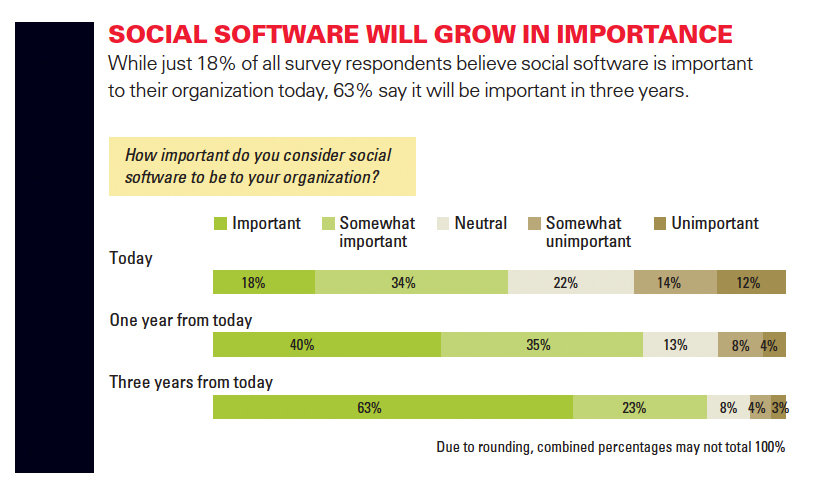
A new generation of workers is building momentum for new modes of collaboration and communication enabled by social business. MIT Sloan School of Management professor Wanda Orlikowski, who researches the interface between technology and organizations and the implications of new digital tools in the workplace, says: “Companies need to get started because this is here and it’s here to stay, especially for the Millennial Generation. This is what they are used to.”
Implementing social business initiatives, however, has been a difficult process for many organizations. The research and advisory firm Gartner estimates the failure rate for social business projects at 70%.3 Why such a high failure rate? A number of factors could be responsible, including not using enterprise software to solve a true business problem; failing to integrate social software into an organization’s daily workflow; and a lack of understanding and support from senior management.
Whatever the difficulties organizations have with adopting social business activities, social business appears to be a trend with staying power. Andrew McAfee, a principal research scientist at MIT’s Center for Digital Business and the author of the book Enterprise 2.0, told us, “I have never spoken to an executive or a manager who says, ‘I just long for the days when we collaborated in the old style and e-mail was all we had and nobody had a voice. Man, that was so fantastic. Let’s please go back there.’”4
Who Values Social Business Most — and Least
Our survey data offers several insights into how the value of social business is perceived among small, midsize and large companies, within the C-suite and across industries.
Opposite Ends Of The Spectrum
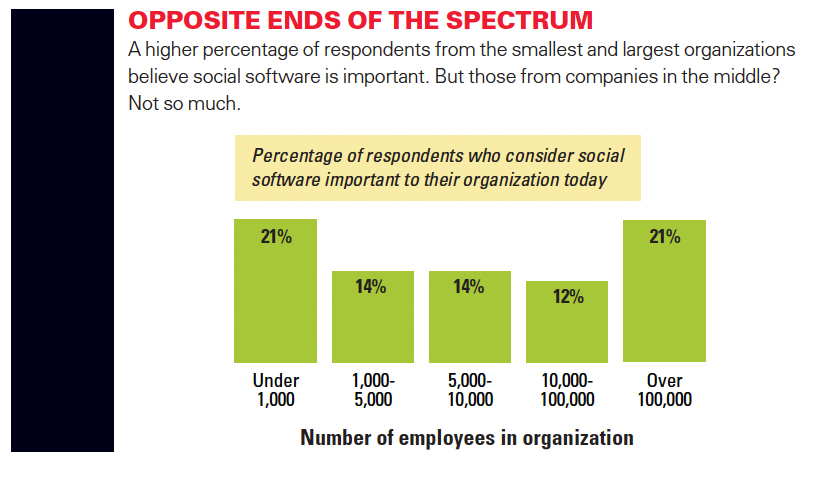
Size Matters. According to our survey, the largest organizations (those with over 100,000 employees) and the smallest organizations (those with less than 1,000 employees) tend to appreciate the value of social business tools today more than midsized organizations. (See “Opposite Ends of the Spectrum.”)
Gerald Kane, an assistant professor at Boston College who studies the strategic use of information technology to create business value, says this is not surprising: “I think smaller firms like social business because they don’t have the buying power or the resources to conduct traditional media campaigns. They can use social media to increase their voice, and connect with customers to really make themselves seem bigger than they are.” He notes that very large, resource-rich organizations can afford to experiment with trendy technologies like social media. “It can make them seem smaller, more intimate than they are, less the big corporate monolith than a collection of people who really care about their products and customers.”
Rick Wion, director of social media for McDonald’s, offers this story about how his company is able to engage with customers personally through social media:
We received a tweet one day from a mom who said, “Hey, McDonald’s, do you know what it does to a little boy to get The Littlest Pet Shop when he wanted a Wolverine toy?” The mom had ordered a Happy Meal for her four-year-old son, but instead of getting the boys’ toy, he got the girls’ toy. The boy was upset, which created a major headache for her. In response to her tweet, we mailed her a boy’s toy, and she was super happy. It turns out that she writes a blog that’s read by about 50,000 people each month, and she wrote a post saying, “Hey, McDonald’s, I’m loving it.” She’s turned into a huge advocate for us. I see her all the time on Twitter, talking about McDonald’s and even defending us against critics. We changed this person from a customer with a complaint to a huge advocate, all by doing this one little thing on Twitter. We understand the power of making one customer happy.
Perceptions Of Social Business Vary Widely By Industry
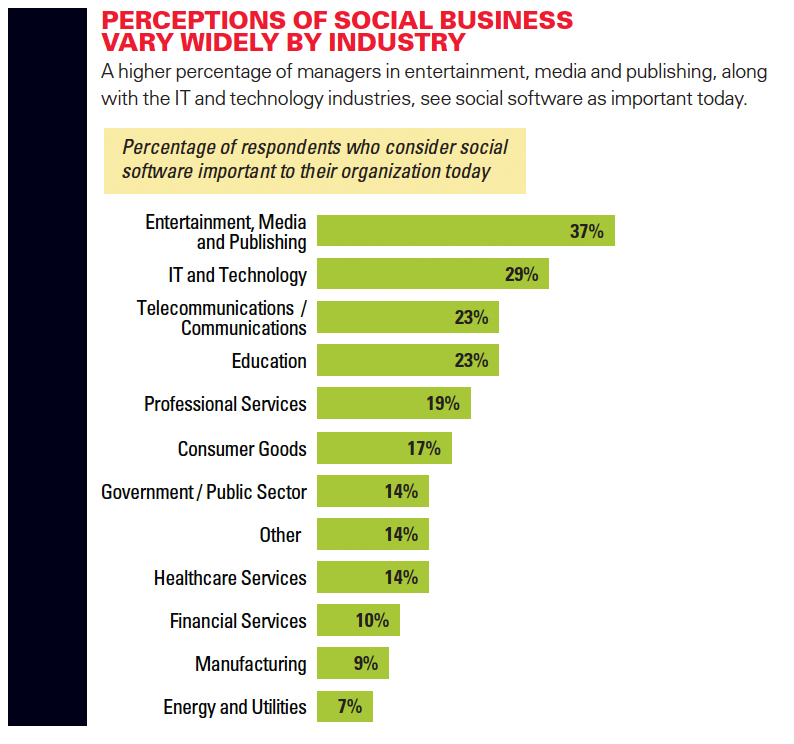
Media and Technology Industries are Early Adopters. Based on our survey data, respondents in the entertainment, media and publishing industries and the IT/technology industries tend to see the most value from social business tools. (See “Perceptions of Social Software Vary Widely By Industry.”) Culture may play a role. Managers from these sectors see their companies as both more open to new ideas and innovative at higher rates than respondents in other industries. Eighty-eight percent of managers in what we are calling the media industries believe their companies are open to new ideas, and 68% consider themselves innovative. For the tech industries, the numbers were 77% and 69%, respectively — both higher than the average in other industries.
Media and technology companies share other distinctive practices. Respondents in these industries are more likely to say their companies are consistently creating or introducing new social business initiatives with customers and suppliers than do managers in other industries. Moreover, they are much more likely to incorporate social data into their ERP systems than other industries — though no industry scores high on this measure.
Here’s how social business tools are changing the way work is done at one large entertainment company. The company uses Chatter — a social enterprise platform from salesforce.com — to help fill 2 million advertising spots spread across 15 television properties. Before they began using Chatter, employees described the coordination between the sales and marketing teams as “disjointed.” Salespeople did not have a clear understanding about the availability of slots they could offer to advertising customers.
As company staff started using the social enterprise platform, coordination between marketing and sales dramatically improved. Account executives from any of the media company’s property could use the Chatter platform to view advertisers and advertising slots at other business units and then interact with their counterparts in these business units to fill gaps in their own advertising portfolios.
Another value that comes from the company’s improved coordination emerged in 2011 when a cruise ship sank off the coast of Italy. One of the company’s executives received an e-mail about the disaster the next morning when he was still in bed, and he quickly realized that the company had a lot of ad spots that day from cruise advertisers. Through Chatter, he was able to pull the ads because he believed it wouldn’t benefit anybody to be advertising cruises that day.
Two hours later the owners of the cruise ship ads requested that the company pull the advertising. The executive was able to say, “Don’t worry, guys, I already pulled them for you.” The executive said that his team’s level of coordination and speed of response would have been difficult to achieve without using the social platform.
The Views From The C-suite
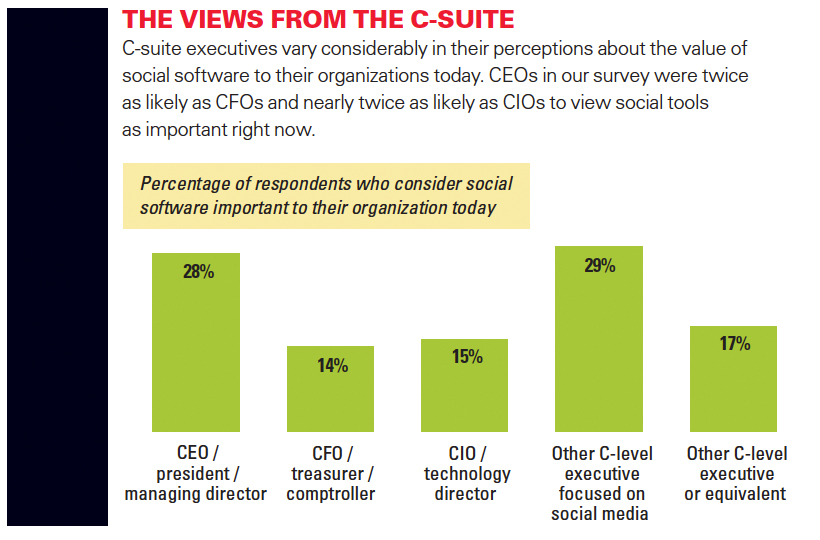
Views From the C-Suite Vary. According to our survey, C-level executives vary considerably in their perceptions about the value of social business to their organizations today. On average, across all industries, CEOs, presidents, managing directors, board members and CMOs are the most likely C-level executives to perceive social software as important today. Indeed, CEOs in our survey were twice as likely than CFOs and nearly twice as likely than CIOs to view social tools as important right now. (See “The Views From the C-Suite.”)
It is less surprising that CFOs do not place a high value on social business software. CFOs focus on investment returns, and our respondents report that their organizations tend not to measure the ROI of social software use. That CIOs perceived so much less value than CEOs, presidents and managing directors was more surprising. Gerald Kane explains CIOs’ relative lack of interest in social business:
CIOs can be terrified of social for a number of reasons. In many cases, social wasn’t their idea. In addition, employees are going to use it anyway, because they can use smartphones or laptops offline to circumvent all of the blocking of the sites that happens in most organizations. Another reason is that this is a data security nightmare. In the previous generation of IT, like ERP systems, IT was a very controlled environment. Social is the opposite.
Kane’s assessment has quantitative research support. In 2010, Gartner surveyed 757 non-IT professionals in Germany and the U.S. and found that 15%-30% of this group used unofficial social software for work purposes, “even in enterprises with an official tool in that category. For example, 21% of respondents use mostly unofficial wiki tools in enterprises that have official wiki tools.”5
Social business may occupy a “blind spot” for some CIOs. Keri Pearlson, an entrepreneur, consultant and adjunct professor at Babson College, suggests:
CIOs tend to be either strategists or keep-the-lights on kind of executives. The strategist CIO may be preoccupied with large-scale, enterprisewide kinds of issues, and few companies have articulated a vision for how they want to use social business corporatewide. The keep-the-lights-on CIO may not see a value in social business because it is difficult to immediately see how it will reduce the cost of operations. It’s just not a priority for them. That said, many CIOs do understand that social business is coming and they will have to deal with it.
Despite their differences regarding its importance today, 70% of CEOs (along with presidents and managing directors) and CIOs in our survey believe that social business will be important to their organization in three years. This suggests that many CIOs regard social business as neither a threat nor a passing fad. They may simply be cautious about jumping in before others demonstrate its value.
Where the Business Value Is
Social Software’s Importance For Key Business Challenges
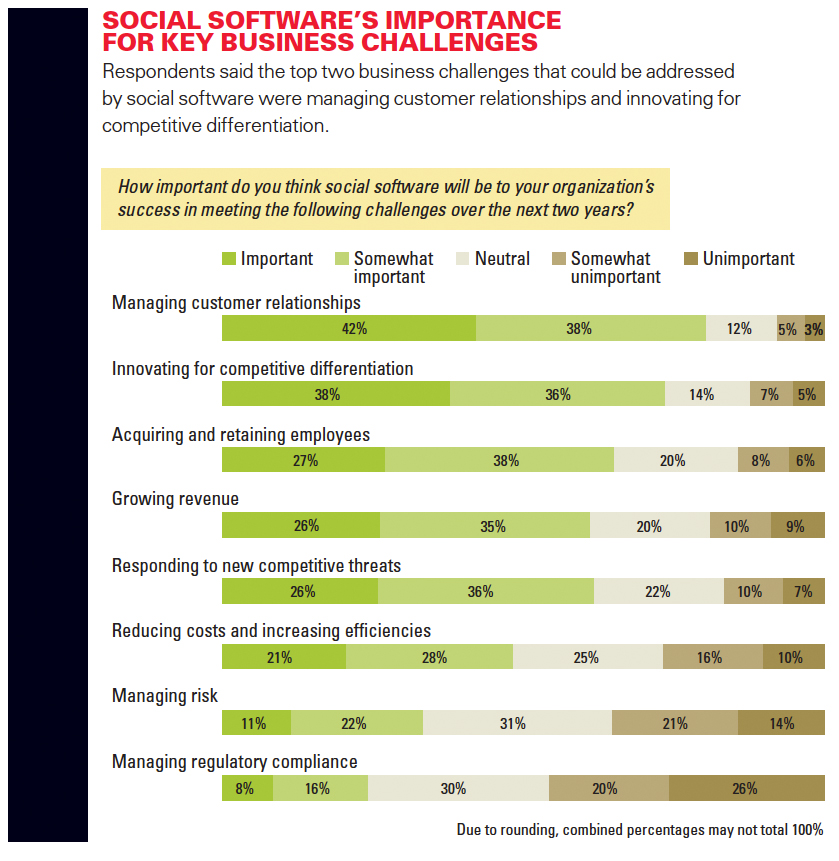
We asked our respondents how important they thought social software would be to their organization’s success in meeting eight specific business challenges over the next two years. (See “Social Software’s Importance for Key Business Challenges.”) The top two business challenges that could be addressed by social software were managing customer relationships and innovating for competitive differentiation.
But in our interviews with thought leaders and executives, we found that, in addition to customer relationship management and innovation, operations and leadership are also benefiting from social tools. Four areas — managing customer relationships, innovation, operations and leadership — are where social business is creating significant opportunity, and for some companies, significant value.6
Managing Customer Relationships. Organizations are using social software, social media and social networking to improve their relationship with customers in a number of ways: monitoring online communities; creating and supporting virtual communities; developing new communication channels; and fostering a wide range of customer engagements, including coupons, contests and other sponsored events. With their social business activities, enterprises have been able to enhance their understanding of and engagement with customers. At the same time, customers, vendors and suppliers are clearly willing to engage with business in online social forums. In particular, product fan sites have proliferated across the Web, increasing the visibility of influencers and a core customer base.
For instance, in 2010, McDonald’s launched McRib, a limited-time-offer sandwich. It quickly developed a loyal fan base that was “raving about the product in social media,” according to Rick Wion:
When we saw these superfans, we decided to use social media to engage with them. We found three of the biggest McRib fans. One had built the first Facebook fan page for McRib. Another was an author who had written a book chapter about McRib. A third man, from Minnesota, built a Google map of McRib locations. If you saw the McRib at a restaurant, you could pin it on a Google map, and other people could see it and know where they could go and get one.
We used their stories to tell the McRib story through Facebook and Twitter, and connected them with bloggers so that people heard about these fans. We had them at a media launch event. These customers were amazing spokespeople. What better way to get people excited about McRib than showcase three of its biggest fans?
It created not only a huge buzz in the core audience for McRib, but it also had a ripple effect. We started to see people saying, “What’s all this buzz about? I’ve never had McRib before. I’m going to go try it. I’m going to go buy it.” The buzz of the core audience brought in new customers. This was a huge success for us.

McDonald’s used social media to engage with fans of its McRib sandwich.
Innovation. Companies are also using social business activities to source new ideas and refine existing products and services. Survey respondents say that innovation will be the second-most important use of social tools in two years, after managing customer relationships.
These new ideas are coming not only from within the company but also from a more engaged group of customers. This is a relatively new phenomenon, or at least newly recognized. The traditional view has been that producers, and only producers, innovate. “This traditional innovation paradigm is fundamentally flawed,” writes MIT Sloan professor Eric von Hippel and colleagues. “Consumers themselves are a major source of product innovations.”7 In some instances, social business activity mediates or forges the links between these consumer innovators and business. Volvo, Nike, Lego and Threadless (a Chicago-based clothing manufacturer and retailer) are just a few of the companies that have used virtual consumer environments to help improve products.8
Operations. From the perspective of operational performance, social business offers value by enabling knowledge to flow into and within an organization. Andrew McAfee sometimes cites former Hewlett-Packard CEO Lew Platt’s comment, “If only HP knew what HP knows, we’d be three times more productive,” when trying to persuade CEOs of the value of social business. John Hagel III, co-chairman of Deloitte’s Center for the Edge, suggests that social business can help improve operational performance by advancing knowledge flows:
Increasingly, the ability to succeed hinges on participating in a broader and more diverse range of knowledge flows, both internally and externally to the enterprise. Sixty to 70% of headcount time in most functions is consumed by handling exceptions, things that get thrown out of automated processes. The employee typically scrambles around, can’t resolve it on his own and needs to get a number of other people engaged. We need to find those people, find ways to engage them as a group, get the relevant data. That is a hugely inefficient process today. Social technologies are providing an opportunity to significantly increase operating performance of a business, and that’s really the key driver of adoption of social technologies. This is a generation of technology that can be extremely helpful in terms of scaling participation in knowledge flows.9
Nationwide Mutual Insurance Company, a U.S.-based insurer with annual revenues in excess of $20 billion, offers a window into how companies are creating knowledge flows to solve real business problems. Last year, a Nationwide customer was stranded on vacation when his RV broke down. The customer called the Nationwide call center to see if his policy covered the situation. Due to the particulars of the customer’s circumstances, the call center agent was unsure and posted the case on the company’s internal collaboration platform. People from across the company, from product, claims and underwriting groups, began offering their feedback. Within 30 minutes, the call center rep had a detailed approach to helping the customer and covering the repair costs. Without this internal collaboration tool, this particular issue might have taken hours or days to resolve; the typical call center software has no ability to let people from other parts of the company participate in problem solving.

SAP has an online community with more than 2 million members, including customers, partners and others.
Image courtesy of SAP.
Leadership. Social business activities can make valuable contributions to leadership in at least two different areas: strategic insight and strategic execution. In these areas, social tools can help leaders sharpen their vision and extend their reach. SAP is an example of a company using its online community to generate strategic insights for the executive team.
Another way that social business can help companies gain strategic insights is through sentiment analysis — for instance, analyzing Twitter streams or activity in online communities — to anticipate shifts in the competitive landscape. New software technologies can make sense of massive amounts of streaming data from Twitter or Facebook and provide insights about real-time consumer trends. “Before, you might hear problems with the brand or product through a 1-800 number or complaints or warranty issues,” says Donna Hoffman, a professor at the University of California, Riverside and co-director of its Sloan Center for Internet Retailing. “Now it is coming from the product development function or from listening to what is happening online.”
Social business activities also offer a way to extend the reach of organizations, including that of their leadership. A business-to-business company with a strategy to reach the end user in order to build product demand can use social tools to engage directly with the consumer. And in corporations with a franchisee network, social tools can be used to effect change in front-line behaviors, even when these front-line employees do not work directly for an organization.
Connecting Leadership and Culture
However, in order to create value with social business, some companies must address difficult organizational issues that arise with leadership and culture. According to Charlene Li, “The biggest determinants, by far, of whether you will be successful at social business are leadership and culture.”
The Importance of Leadership. Our survey results suggest that leadership is critical to increasing the use of social tools within an organization. We asked respondents, “What factors do you see facilitating the adoption of social software in your organization?” The top two answers: clear vision for how social media supports business strategy, and senior management support. Lack of management understanding was the top answer to the question, “What internal barriers do you see impeding the adoption of social software in your organization?” (Risk and security concerns are the top external barriers to social software adoption.)
But do leaders have the tools they need to drive adoption? Our findings suggest that a key resource is missing: measurement. In our survey, the most frequently cited type of measurement of social software use is: not measured! Lack of business case was the second most-cited internal barrier to adoption. Without measured results, it can be difficult to create effective incentive structures or monitor the progress of pilot initiatives.
Do your leaders have the right mindset for integrating social business into your organization? Andrew McAfee notes that someone’s receptivity to social business has a lot to do with his or her qualities as a leader. For those who encourage the free exchange of ideas, there’s no conflict. But for those who prefer to suppress opinions, social business is seen as a threat:
Social business can undermine people’s power. Especially if you’re a jerk boss who has thrived on being the gatekeeper for information and suppressing your people’s opinions, this could be unpleasant for you. If you’re the boss of a project that’s behind schedule and you try to convince your higher-ups that it’s on schedule, these new social tools will be uncomfortable for you. For what I would call high-quality or more enlightened leaders, there is no conflict here. For command-and-control bureaucrats who are afraid of having a more multivoiced organization, this stuff is scary. But I don’t want a lot of those managers in my organization.
Having the right leadership mindset — being open to new ideas and encouraging others to share rather than hold onto information — is an important determinant of whether social business will gain traction in your organization.
A Cultural Shift. As mentioned earlier, industries that are already deriving value from social business have cultures that tend to be more open to new ideas and more collaborative than other companies. Sharing information may not come easily, especially in corporate cultures where what you know is an important source of your power in the organization. Transitioning to a culture in which sharing knowledge is a source of power can threaten a nonsocial feature of human nature — self-protection. We asked several thought leaders what they believed about the challenge of making this organizational transition.
Marshall Van Alstyne, an associate professor of information systems at Boston University, suggests that one way to promote a cultural shift toward social business is to ensure that people have incentives to share rather than hoard information:
Think of it in terms of information scarcity versus information abundance. If information is scarce, then you, as the control point for access to that information, have a lot of power. If information is abundant and it’s easy to go around you, you can benefit by being the first to provide that information. In a rich social business environment, information is abundant, so you have an incentive to share information you have, or someone else will and you lose out. Even if it’s not quite as good, you can provide it a lot earlier and in such abundance that other folks are still happy to have it.
Consider SAP’s developer ecosystem where developers can answer one another’s questions. Before this system, a value-added reseller on top of SAP’s software had no particular reason to help out another value-added reseller. As a matter of fact, one might not want to answer the question of another reseller because it might actually help them out and make them more competitive. But after the introduction of this question-and-answer marketplace, things shifted completely. Now you earn points in proportion to the value of your answers. Now the value-added resellers are telling their employees to go in and answer the questions of other resellers to prove, “Hey, we’re the ones with the expertise, not those guys.” It’s completely shifted the incentives. Folks are now pushing their information into the marketplace in a way that benefits SAP. It’s a really clever mechanism that completely inverts the incentives from one of hoarding to one of information sharing.
As these observations suggest, social business, considered as a group of activities, can be challenging, or even threatening to the status quo. However, meeting one organizational requirement like leadership is not sufficient for an effective social business engagement or for an effective execution of an enterprise-level social business strategy. “Social initiatives within an organization need champions to support and grow these initiatives,” says Gerald Kane, “but champions and strategies alone will not push the organization forward.” Other key factors, in addition to leadership and culture, include social tools that are simple to use, properly structured incentive systems, a clear purpose for what problems the social initiative is intended to solve, and clear direction about how to communicate with social tools, both inside and outside the organization.10
Given that social business is still just getting started, you may be tempted to wait until the technology matures or there is more evidence to support its business value. But that approach may delay achieving the potential of social business in your organization, to the detriment of your customer relationship management, innovation, leadership and operations. According to MIT professor Alex (Sandy) Pentland, “Like any emerging technology trend, social business can seem perpetually just out of reach. Let’s wait a year, the thinking goes. It’s not quite real, not quite ready for prime time. If that’s your approach to social business, you may be overestimating the amount of effort it takes to start putting this trend to work for your organization today.”11
References (15)
1. For more information about SAP mentors, see M. Finnern, “SAP Mentor Program,” SAP Community Network (blog), November 15, 2007, http://scn.sap.com; and “SAP Mentor Initiative FAQs,” accessed May 25, 2012, https://wiki.sdn.sap.com
2. As used in this document, “Deloitte” means Deloitte Consulting LLP and Deloitte Services LP, which are separate subsidiaries of Deloitte LLP. Please see www.deloitte.com/us/about for a detailed description of the legal structure of Deloitte LLP and its subsidiaries. Certain services may not be available to attest clients under the rules and regulations of public accounting.




